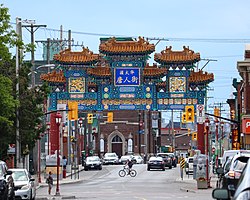Chinatown | |
|---|---|
Business Improvement Area (BIA) | |
 | |
 | |
| Coordinates: 45°24′39″N75°42′26″W / 45.41084°N 75.70721°W | |
| Country | |
| Province | |
| City | |
Ottawa's Chinatown is located along Somerset Street west of downtown Ottawa. It runs from Bay Street in the east to Preston Street in the west (according to the Chinatown BIA). Signs for Chinatown continue along Somerset until Preston Street, and Chinese/Asian restaurants can be found even farther west.
Contents
The BIA was designated in 1989 and was named Somerset Heights until it was renamed Chinatown in 2005.
While officially designated "Chinatown," the area is home to businesses from many Asian cultures, such as Vietnamese, Korean and Thai. Restaurants specializing in Phở and dim sum are quite common. The Ottawa Chinatown has on one hand an urban character as it is not a cluster of strip malls, but on the other hand, it is focused on one commercial street, surrounded exclusively by residential areas.
A traditional Paifang archway has been built upon the entrance to the western section of Chinatown over Somerset Street, west of Bronson Avenue. It was unveiled in the early Fall of 2010. [1]
